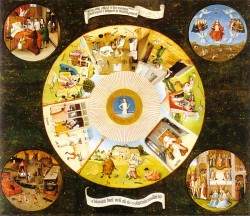
Lane 1985
“Bosch’s Tabletop of the Seven Deadly Sins and the Cordiale Quattuor Novissimorum” (Barbara G. Lane) 1985
[in: William W. Clark (ed.), Tribute to Lotte Brand Philip, art historian and detective. New York, 1985, pp. 89-94]
The four roundels in the corners of the so-called Tabletop of the Seven Deadly Sins (Madrid, Prado), representing Death, the Last Judgment, Hell and Heaven, are usually considered to be workshop productions and received little iconographic attention in the past. But the relationship between these roundels and the central part of the panel can be clarified with the help of a hitherto relatively unknown contemporary literary source, the Cordiale quattuor novissimorum, written by the monk Gerard van Vliederhoven between 1380 and 1396.
Over 200 Latin manuscripts of the Cordiale still exist. Before 1400 the text was translated into Dutch and the numerous fifteenth-century Dutch manuscripts (in which the text is called Die vier uterste) derive from this early translation. Furthermore 46 Latin editions before 1500 have been catalogued and 13 of these have been printed in the Netherlands. The Dutch translation was printed 18 times between 1477 and 1540. It is obvious then that both the Latin and the Dutch versions of the Cordiale were well-known in the Netherlands during the period in which the Tabletop was painted.
The prologue of the Cordiale opens with a quotation from Ecclesiasticus (7: 40): Memorare novissima tua et in (a)eternum non peccabis [remember your Last Things and you will never sin]. The same theme appears on the Prado Tabletop. The Latin versions of the Cordiale conclude with Deuteronomy 32: 28-29 : Gens absque consilio est, et sine prudentia. Utinam saperent, et intelligerent, ac novissima providerent [for it is a people without counsel and without prudence; if they were wise, they would understand this and they would keep their Last Things in mind]. The same biblical quotation is written across the top of the Tabletop.
This does not prove that the Cordiale was a source for the Tabletop but the parallels between the two works are undeniable. The Tabletop is a pictorial summary of the contents of the Cordiale: the four roundels in the corners represent those things that the viewer must constantly remember to resist the temptations portrayed in the central part. Because the quotation from Deuteronomy is omitted in the Dutch versions, the Latin version must have been a source for the Tabletop. It is uncertain whether the painter has read the whole text: only the beginning and the conclusion of the Cordiale show a clear parallel with the Tabletop.
Lane also publishes an engraving by Hieronymus Wierix (circa 1585) with The Four Last Things. Four roundels represent the Last Things, the central part shows Jesus at the Cross and at the bottom the quotation from Deuteronomy is present again.
It is indeed hard to prove whether the Cordiale has been a source of inspiration for the Tabletop. The Wierix engraving makes it highly probable that we are dealing here with topical material showing up each time the Last Things had to be depicted or described. This aspect needs further research. It is undeniable, though, that the Tabletop and the Cordiale express similar religious ideas, which is also proven by other passages from the Cordiale (to which Lane does not refer in her article). We have not yet been able to check whether the quotation from Deuteronomy is indeed omitted in all Middle Dutch versions. But in the Middle Low German version (edition Dusch 1975, p. 115) the scriptural verses àre quoted at the end!
[explicit]